The Pennsylvania Railroad, legal name The Pennsylvania Railroad Company, also known as the "Pennsy", was an American Class I railroad that was established in 1846 and headquartered in Philadelphia, Pennsylvania. At its peak in 1882, the Pennsylvania Railroad was the largest railroad, the largest transportation enterprise, and the largest corporation in the world, on par with the London & North Western Railway.

The Allegheny Portage Railroad was the first railroad constructed through the Allegheny Mountains in central Pennsylvania. It operated from 1834 to 1854 as the first transportation infrastructure through the gaps of the Allegheny that connected the midwest to the eastern seaboard across the barrier range of the Allegheny Front. Approximately 36 miles (58 km) long overall, both ends connected to the Pennsylvania Canal, and the system was primarily used as a portage railway, hauling river boats and barges over the divide between the Ohio and the Susquehanna Rivers. Today, the remains of the railroad are preserved within the Allegheny Portage Railroad National Historic Site operated by the National Park Service.

The Main Line of Public Works was a package of legislation passed by the Commonwealth of Pennsylvania in 1826 to establish a means of transporting freight between Philadelphia and Pittsburgh. It funded the construction of various long-proposed canal and road projects, mostly in southern Pennsylvania, that became a canal system and later added railroads. Built between 1826 and 1834, it established the Pennsylvania Canal System and the Allegheny Portage Railroad.
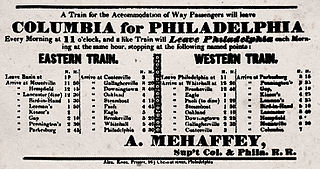
Philadelphia and Columbia Railroad (P&CR) (1834) was one of the earliest commercial railroads in the United States, running 82 miles (132 km) from Philadelphia to Columbia, Pennsylvania, it was built by the Pennsylvania Canal Commission in lieu of a canal from Columbia to Philadelphia; in 1857 it became part of the Pennsylvania Railroad. It is currently owned and operated by Amtrak as its electrified Keystone Corridor. The Philadelphia and Columbia Railroad's western terminus was located near the former ferry site known as Wright's Ferry, in the town once of that name, but now Columbia in Lancaster County. There the P&CR met with the Pennsylvania Canal—navigations and improvements on the Susquehanna River east bank approximately 30 miles (48.3 km) south of Harrisburg, Pennsylvania. Most of its right-of-way was obtained by the actions of the Pennsylvania Canal Commission which operated the railroad under the various enabling acts of the Pennsylvania legislature known as the Main Line of Public Works in support of a far sighted plan to link the whole state by canals. With an engineering study reporting back a finding that obtaining sufficient waters to flood the intended 80+ mile canal from Philadelphia to Columbia, the Canal Commission and legislature authorized the railway on the right of way intended for the canal.
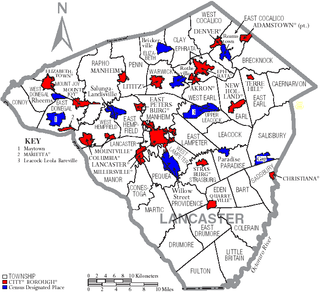
Transportation in Lancaster County, Pennsylvania has a long and variegated history. An early-settled part of the United States, and lying on the route between Philadelphia and Harrisburg, it has been the site of early experiments in canals, railroads, and highways. Before all these, at least ten Native American paths crossed parts of the county, many connecting with the Susquehannock village of Conestoga.
The Keystone Subdivision is a railroad line owned and operated by CSX Transportation in the U.S. states of Maryland and Pennsylvania. The line runs from Cumberland, Maryland, west to McKeesport, Pennsylvania, along a former Baltimore and Ohio Railroad (B&O) line. The line includes the well-known Sand Patch Grade over the Allegheny Mountains.

The Harrisburg Subdivision is a railroad line owned by CSX Transportation in Pennsylvania. The line is located in Philadelphia, and connects Greenwich Yard and the Philadelphia Subdivision with the Trenton Subdivision along a former Pennsylvania Railroad line. Much of the Harrisburg Subdivision is the High Line' or West Philadelphia Elevated along 31st Street over the 30th Street Station area.

The Trenton Subdivision is a railroad line owned by CSX Transportation in the U.S. states of Pennsylvania and New Jersey. The line runs from CP NICE in Philadelphia, Pennsylvania, northeast to Port Reading Junction in Manville, New Jersey. The line was formerly part of the Reading Company system.

The Lurgan Branch is a railroad line owned and operated by the Norfolk Southern Railway in the U.S. states of Pennsylvania and Maryland. The line is part of the NS Harrisburg Division and runs from Harrisburg, Pennsylvania southwest to Hagerstown, Maryland along former Reading Company and Pennsylvania Railroad lines. Its northeast end is at a junction with the Harrisburg Line, Pittsburgh Line, Royalton Branch, and Amtrak's Keystone Corridor ; its southwest end is at the beginning of the Hagerstown District. At Lemoyne it intersects the Enola Branch.
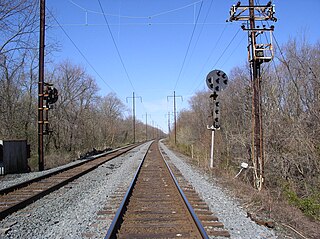
The Enola Branch is a rail line segment of the Port Road Branch and was a rail line. The Enola Branch rail line segment and the rest of the Port Road Branch is owned and operated by the Norfolk Southern Railway in the U.S. state of Pennsylvania. The rail line segment runs from Washington Boro northwest to Marysville and it is a former Pennsylvania Railroad rail line. Its south end is at a former junction with the Atglen and Susquehanna Branch, where the main segment of the Port Road Branch continues southeast. Its north end is at the Pittsburgh Line. Along the way, it meets the York Secondary at Wago Junction and goes under the Lurgan Branch at Lemoyne. Norfolk Southern labels the Enola Branch as part of the Port Road Branch, officially ending the Enola Branch's existence as a rail line, the main segment of the Port Road Branch runs from Marysville south to Perryville, Maryland. The line goes through the Enola Yard.
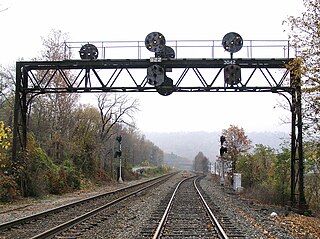
The Buffalo Line is a railroad line owned by the Norfolk Southern Railway in the U.S. states of New York and Pennsylvania. The line runs from Buffalo, New York southeast to Rockville, Pennsylvania near Harrisburg, Pennsylvania along a former Pennsylvania Railroad line. Its north end is at Seneca Yard in Buffalo, with no direct access to the Lake Erie district, and its south end is at the Pittsburgh Line at Rockville. The line is operated by the Buffalo and Pittsburgh Railroad between Buffalo and Machias, New York, the Western New York and Pennsylvania Railroad between Machias and Driftwood, Pennsylvania, and the Norfolk Southern Railway between Driftwood and Rockville.
The Conemaugh Line is a rail line owned and operated by the Norfolk Southern Railway in the U.S. state of Pennsylvania. The line runs from Conpit Junction, Pennsylvania northwest and southwest to Pittsburgh, following the Conemaugh, Kiskiminetas, and Allegheny rivers, on the former main line of the Conemaugh Branch of the Pennsylvania Railroad (PRR). At its east end, it merges with the Pittsburgh Line; its west end is where it merges with the Fort Wayne Line at the northwestern tip of Allegheny Commons Park. The line was used by the PRR as a low-grade alternate to its main line, which is now part of Norfolk Southern's Pittsburgh Line, in the Pittsburgh area.
The New Castle Branch was a rail line owned and operated by the Pennsylvania Railroad in the U.S. state of Pennsylvania. The line ran from New Castle north to Stoneboro, and is now entirely abandoned. At its south end, the line intersected the Erie and Pittsburgh Branch and Mahoningtown Branch. When the New Castle Branch ended at Stoneboro, the PRR had trackage rights east along the New York Central Railroad's Stoneboro Branch to Oil City and the Allegheny Branch, Chautauqua Branch, and Salamanca Branch.
The Pittsburgh to St. Louis Main Line was a rail line owned and operated by the Pennsylvania Railroad in the U.S. states of Pennsylvania, Ohio, Indiana, and Illinois. The line ran from Pittsburgh, Pennsylvania west via Steubenville, Ohio, Columbus, Ohio, Dayton, Ohio, Indianapolis, Indiana, Terre Haute, Indiana, and Vandalia, Illinois to East St. Louis, Illinois. In addition to its east end in downtown Pittsburgh, where it met the Main Line and Pittsburgh to Chicago Main Line, junctions included the Columbus to Chicago Main Line at Columbus, the C&X Branch at Xenia, the Columbus to Indianapolis Main Line via Bradford at New Paris, the Richmond Branch and Fort Wayne Branch at Richmond, the Louisville Branch and I&F Branch at Indianapolis, and the Peoria Branch at Farrington, Illinois.
The Delaware Extension was a rail line owned and operated by the Pennsylvania Railroad in Philadelphia, Pennsylvania.

The Pennsylvania Canal, sometimes known as the Pennsylvania Canal system, was a complex system of transportation infrastructure improvements, including canals, dams, locks, tow paths, aqueducts, and viaducts. The canal was constructed and assembled over several decades beginning in 1824, the year of the first enabling act and budget items.
The Harrisburg, Portsmouth, Mountjoy & Lancaster Rail-Road (HPMtJ&L) was an early American railroad built to connect three main population centers in east-central Pennsylvania.
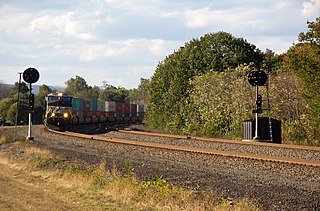
The Pittsburgh Line is the Norfolk Southern Railway's primary east–west artery in its Pittsburgh Division and Harrisburg Division across the U.S. state of Pennsylvania and is part of the Keystone Corridor, Amtrak-Norfolk Southern's combined rail corridor.
The New Portage Branch was a rail line which ran between the New Portage Tunnel and Duncansville, Pennsylvania.














